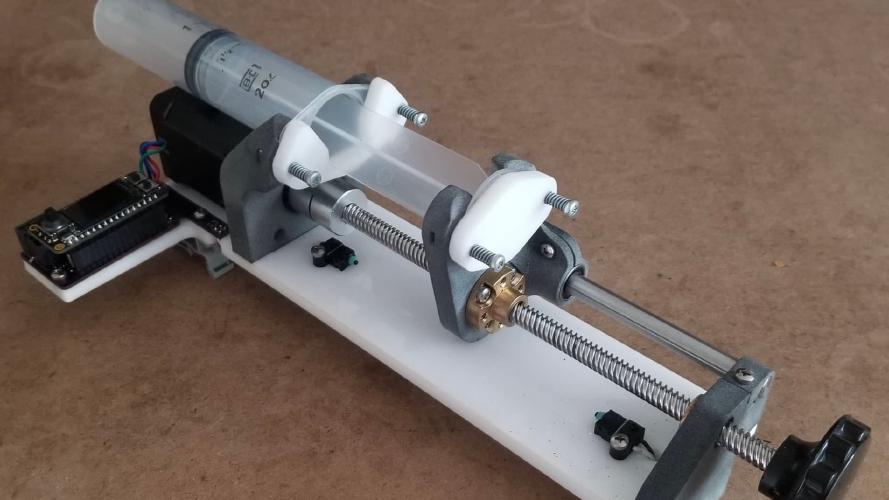Background
Syringe pumps are excessively expensive. The expansion of the hobbyist 3D printing market has lowered the cost and increased the availability of 3D printer components due to demand for DIY kits and replacement parts. By leveraging these low cost readily available components, along with micro-manufacturing services (OSH Park, Ponoko, Shapeways etc.), there is no reason that the functionality of an expensive commercial pump can’t be replicated at 1/10th the cost. Therefore, my goal was to make an easy to assemble, open-source syringe pump that is an order of magnitude less expensive without sacrificing reliability and resolution.
I am not the first to build an DIY syringe pump. Here are some similar projects:
- Open Syringe Pump by naroom
- Open-source syringe pump by Michigan Tech’s Open Sustainability Technology Lab
- SyriGo by Ocram
- Open source syringe pump by Will Patrick
Design
The major difference between my take on the DIY syringe pump, and the ones above, is my abstaining from using 3D printed components. I chose to use lasercut parts because they are more accurate, more precise, stiffer, and more conducive to rapid iteration and/or making large quantities (minutes to lasercut instead of hours to 3D print).
Features
- Easy to build
- ~30 minutes to assemble
- Assembled with screws and nuts. No glue or thread tapping required
- Laser cut 1/4" thick acrylic frame
- Stiff & precise
- No need for finishing/removing support material as with a 3D printed part
- Infuse and retract capable
- Vertically mounted on DIN rail
- Air bubbles rise to the top and exit at start of infusion
- Easy to mount multiple pumps side by side
- 2 limit switches prevent the motor from stalling in either direction
- Controller board that combines microcontroller, stepper driver, color display, joystick, and motor/power connections
- Reprogrammable over USB for complete customization
- Modern stepper driver rotates motor very quietly
- Send precise “dispense {X} µL” serial commands to dispense volume or set an infuse rate and provide an high TTL signal for desired duration
- Can automatically stop experiment when syringe is empty (when infuse limit switch is triggered)
- Lower cost than comparable commercial pumps ($750, $995, $4600)
- Frame ~ $150
- Electronics ~ $50
Volume dispense resolution
Using a 60 mL syringe, the theoretical volume dispense resolution can be calculated as 2.65 μL. The code below demonstrates the calculation. You can modify and run the code here.
from math import pi
#Syringe
innerDiameter = 26.7 #mm
syringeArea = pi * (innerDiameter / 10.0)**2 / 4.0 #cm^2
#Lead screw
pitch = 2 #mm
numStarts = 4
lead = numStarts * pitch / 10.0 #cm
#Stepper Driver
microSteps = 16
#Motor
numSteps = 200 #steps/revolution
#Result
linearResolution = lead / (numSteps * microSteps) #cm
volumeResolution = linearResolution * syringeArea #cm^3 or mL
print(u"{:0.1f} \u03bcm linear resolution".format(linearResolution * 1e4))
print(u"{:0.4f} \u03bcL volumetric resolution".format(volumeResolution * 1e3))
Electrical Design
More to come…
Mechanical Design
Old Versions
Version 1
Latest
2 pumps mounted to behavior rig


